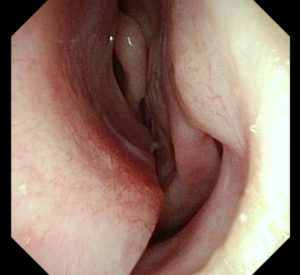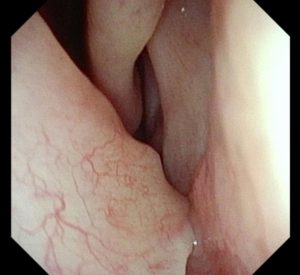My nose is always blocked on one side – the deviated septum!
Nose block is a common complaint we hear in our clinic. Most patients describe blockage which affects both nostrils but in some patients the blockage is always on one side. This significantly affects their quality of life – with poor sleep, mouth breathing, noisy nasal breathing and reduce endurance in sports. Often patients can only get comfortable at night if they lie on one side.
The most common cause of one sided nasal blockage is a deviated nasal septum. The nasal septum is a wall of cartilage and bone that divides the nasal cavity into a left and right nasal cavity. The nasal septum is seldom ever dead straight.

The septum on the left of this image is deviated and obstructs the left nasal passage of this patient
In the 1800s, Sir Morell MacKenzie studied over 2000 skulls and found that only 23% had a straight septum. So in many ways, it’s pretty “normal” to have a deviated nasal septum!

Sir Morell Mackenzie (1837-1892) who established the Hospital for Diseases of the Throat, Golden Square, London in 1863
There are a few unknowns when it comes to the deviated septum. The first is that some people with severely deviated septums don’t seem to feel any sense of blockage. This is may be due to the flow dynamic of air through the nasal passages. It is widely recognized that laminar air flow – no matter how reduced – doesn’t produce a sense of blockage but turbulent flow does.
The second is the cause of the deviation. In a minority, there is an obvious history of trauma that produces a deviation. However in the majority there is no obvious trauma. The proponents of birth trauma i.e. the nose being squashed as a child is delivered cannot explain the presence of septal deviations in people born by Caesarian section!Despite these conundrums, it appears that straightening the septum restores nasal patency and relieves the symptoms of one sided blockage
The operation to straighten the septum is called a Septoplasty. This is a common operation and one that is learned very early on in the training of an ENT surgeon. Yet it is one that is probably never completely mastered! The nasal septum is comprised of cartilage in the front portion but bone at the back. The points where the bone and cartilage join are often areas where there is deviation. The cartilage when deformed has memory and so straightening it is not an easy undertaking.
Septoplasty
A Septoplasty is performed under general anaethesia. Most surgeons will use local anaesthetic injections and solutions that may contain lidocaine or cocaine to achieve good anaesthesia. The operation often takes about an hour but in complex cases it may be longer. There are no external incisions for a Septoplasty. The incisions are made just inside the nostrils and are concealed.
Following the first incision, the lining over the cartilage and bone of the septum is raised. This is often called a mucoperichondrial flap. This lining may be difficult to raise in complex deviations or post-traumatic ones. The cartilage and bone of the septum receive their blood supply from the flap and so any loss of this flap may result in loss cartilage and bone. This can cause a septal perforation (vide infra).
Once the mucoperichondrial flaps are raised (most often on both sides), the deviated portions of the bone and cartilage are cut away. The flaps are then re-apposed and the incision closed. There are various surgical nuances to this approach. Sometimes bits of cartilage are replaced once straightened. One important aspect of this operation is to preserve parts of the septum that maintain the shape of the nose. Over zealous removal of cartilage can cause unwanted changes to nasal contour.
Some surgeons will use splints in the nose to hold the septum together like a sandwich.
What can I expect following a Septoplasty?
At the end of the operation, surgeons may place packs in the nose to stop any bleeding. These are like tampons and are removed a day later. So when you wake up following a Septoplasty, you may find the nose blocked. The nasal packs are not uncomfortable but the blockage can be frustrating. The removal of the packs the following day is a little uncomfortable but it takes all of 5 seconds!
Overall this is not a painful operation but there is some discomfort similar to that felt if you were struck on your nose. Simple painkillers work well.
Most patients spend a night in hospital. After discharge, the nose will feel congested and there will be some blood stained mucus for a few days. I usually advise using saline sprays to keep the nose less congested.
A week after surgery, the splints are removed in clinic. This is painless.
The healing takes up to 6 weeks so there will be some tenderness and congestion for a few weeks. In most cases, regular visits to check on the nose and clear any crusts and clots is necessary.
What are the complications of Septoplasty?
Septoplasty is a safe operation but there are a few complications that are worth nothing. I hasten to point out that most of these complications can be rectified should they occur. Bleeding following a septoplasty is normal but in some cases bleeding may be persistent. Some patients may require a trip back to the operating theatre to stop any bleeding.
A septal perforation or hole in the septum is another complication that can occur. Most septal perforations cause no symptoms but it some patients it may cause crusting, whistling or bleeding.

Septal perforation in a patient following septoplasty. I hasten to add that this patient had surgery elsewhere but this complication can occur in the best surgical hands
The other complication of a septoplasty include a drop in the nasal tip or tip ptosis, or a saddling of the nasal bridge. These complications are rare and associated with disruption of key parts of the nasal septum during surgery.

Tip Ptosis (from the Archives of Plastic Surgery, 2006)

Saddle deformity of the nose (from Plastic and Reconstructive Surgery, 2018)
In summary, septoplasty – when done well – restores nasal patency and carries with it few significant risks.
Share this blog via:








